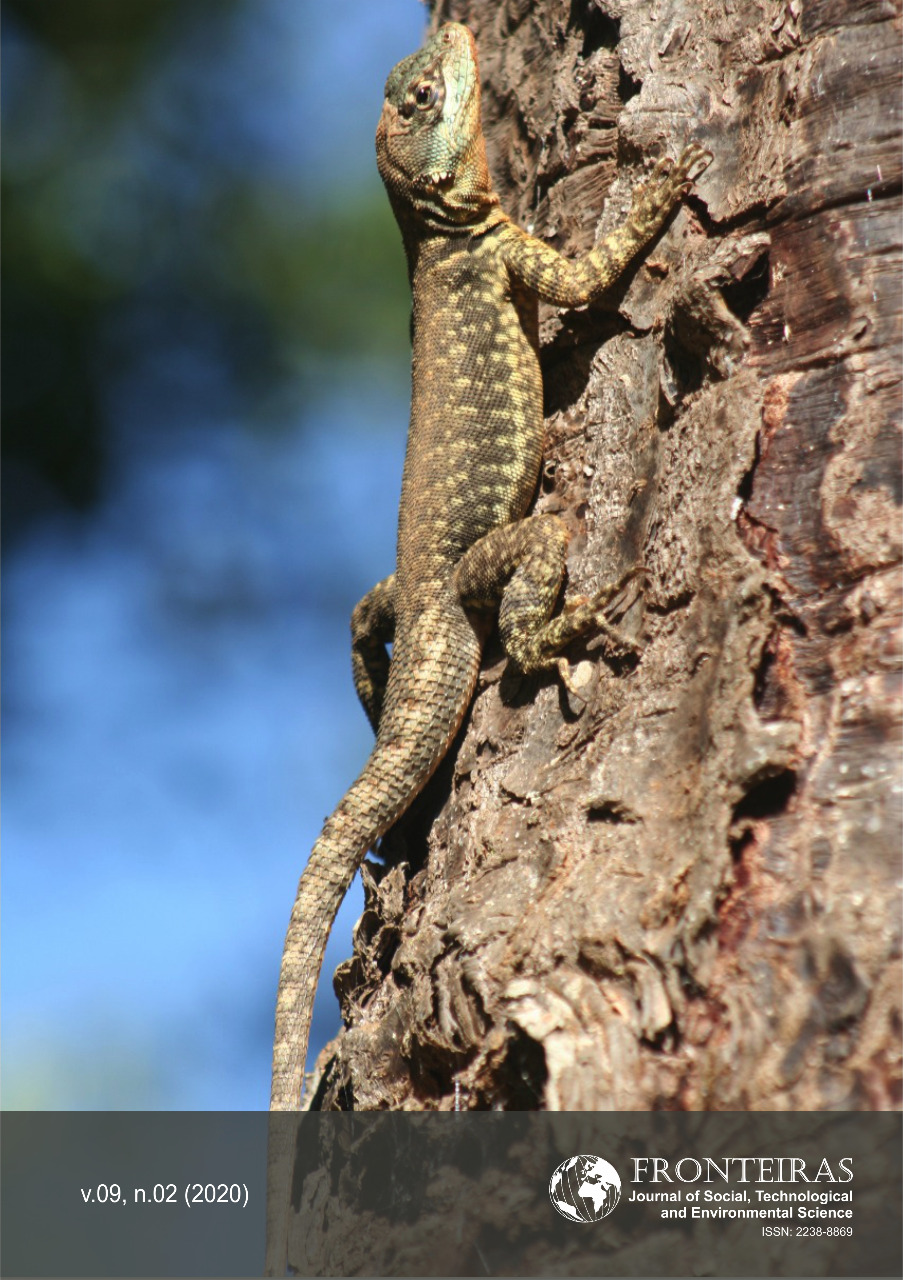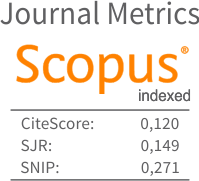Evaluation of the Efficiency of a Septic Tank Combined with Anaerobic Filter, Filled with Plastic Residue, Including a Root Zone
DOI:
https://doi.org/10.21664/2238-8869.2020v9i2.p128-141Palavras-chave:
tanque séptico, filtro anaeróbico, conduítes, zona de raízesResumo
Considering the damages resulting from the dumping of waste in natura in the bodies of water and soil, an alternative system of treatment of domestic effluent with septic tank and an anaerobic filter was installed, following a root zone. The evaluation of the efficiency of the system was based on analyzes of the physical, chemical, biological variables and ecotoxicological tests (toxicity tests with Ceriodaphnia dubia). The conductivity values decreased after treatment (83.4%), from 3380 to 561 µS cm-1. The average efficiency of removal of organic matter was 88.75% and there was a significant decrease in BOD. The removal of phosphorus was 97.68% and nitrogen was 94.7%. The toxicity tests determined an LC50 = 1.70% for the raw effluent and in the treated effluent, an LC50 = 16.63%. The system achieved good efficiency in the reduction of all analyzed parameters. The use of a plastic residue as a filter element has proved quite feasible.
Referências
Associação Brasileira de Normas Técnicas, 1997. NBR 13969: Septic Tanks - Complementary Treatment Units and Final Disposal of Liquid Effluents - Design, Construction and Operation. Rio de Janeiro, 60 pp.
Almeida PGS, Oliveira SC, Chernicharo CAL 2011. Operation of trickling filters post-UASB reactors without the secondary sedimentation stage. Eng. Sanit. Ambient. 16(3):271-280. http://www.scielo.br/pdf/esa/v16n3/v16n3a10.pdf
Andrade Neto CO. The use of the anaerobic filter for sanitary sewage treatment. 2006 [cited 2017 April 6]. Available from: http://www.meiofiltrante.com.br/edicoes.asp?link=ultima&fase=C&id=207
APHA - American Public Health Association, 2005. Standard methods for the examination of water and wastewater. 21th ed. Washington: APHA. 1120 pp.
Bastos RKX, Calijuri ML, Bevilacqua PD, Rios EN, Dias EHO, Capelete BC, Magalhães TB 2010. Post-treatment of UASB reactor effluent in waste stabilization ponds and in horizontal flow constructed wetlands: a comparative study in pilot scale in Southeast Brazil. Water Science Technology 61(4):995-1002. http://dx.doi.org/10.2166/wst.2010.960.
Brasil, 2005 - Conselho Nacional do Meio Ambiente. Resolução CONAMA nº 357, de 17 de março de 2005. It deals with the classification of water bodies and environmental guidelines for its classification, as well as establishes the conditions and standards for the discharge of effluents, and provides other measures [cited 2017 April 29]. Available from: http://www.mma.gov.br/port/conama/res/res05/res35705.pdf)
Brasil, 2011 - Conselho Nacional do Meio Ambiente. Resolução CONAMA nº 430, de 13 de maio de 2011. Provides for the conditions and standards for the discharge of effluents, complements and modifies Resolution No. 357/2005 [cited 2017 April 29]. Available from: http://www.mma.gov.br/port/conama/legiabre.cfm?codlegi=646
Brasil MS, Mato AT, Soares AA 2007. Planting and fenological performance of Typha sp. used in the domestic wastewater treatment under constructed wetland system. Associação Brasileira de Engenharia Sanitária e Ambiental – ABES 12(3). http://dx.doi.org/10.1590/S1413-41522007000300006
Brix H 1997. Do macrophytes play a role in constructed treatment wetlands? Water Science Technology 35(5):11–17. https://doi.org/10.1016/S0273-1223(97)00047-4
Chanakya HN, Khuntia HK 2014. Treatment of gray water using anaerobic biofilms created on synthetic and natural fibers. Process Safety and Environmental Protection 92(2):186-192. https://doi.org/10.1016/j.psep.2012.12.004
Costa JF, Martins WLP, Seidl M, Von Sperling M 2015. Role of vegetation (Typha latifolia) on nutrient removal in a horizontal subsurface-flow constructed wetland treating UASB reactor trickling filter effluent. Water Science Technology 71(5):1004-1010. DOI: 10.2166/wst.2015.055
Couto EA, Calijuri ML, Assemany PP, Santiago AF, Lopes LS 2015. Greywater treatment in airports using anaerobic filter followed by UV disinfection: an efficient and low cost alternative. Journal of Cleaner Production 106:372-379. http://dx.doi.org/10.1016/j.jclepro.2014.07.065
Faulwetter JL, Gagnon V, Sundberg C, Chazarenc F, Burr MD, Brisson J, Camper AK, Stein OR 2009. Microbial processes influencing performance of treatment wetlands: a review. Ecological Engineering 35(6):987-1004. doi:10.1016/j.ecoleng.2008.12.030
Fernandes WV, et al. 2015. Evaluation of the organic matter removal of septic tank effluent using anaerobic filter filled with Luffa cylindrica as support medium. Revista Eletrônica de Gestão e Tecnologias Ambientais 3(1):1-13. doi:http://dx.doi.org/10.17565/gesta.v3i1.12995.
Fia FRL, Matos AT, Fia R, Borges AC, Abreu EC 2015. Influence of nutrient loading and species cultivated on the removal of K, Na, Cu and Zn from swine wastewater treated in constructed wetlands. Revista Ambiente Água 10:542-553. http://dx.doi.org/10.4136/ambi-agua.1216.
Gajurel DR, Li Z, Otterpohl R 2003. Investigation of the effectiveness of source control sanitation concepts including pre-treatment with Rottebehaelter. Water science and technology 48(1):111-118.
Gallagher N, Sharvelle S 2011. Demonstration of anaerobic digestion of black water for methane capture and use in an office building, Water Pract. Technol. 6. DOI: 10.2166/wpt.2011.008
Hemming J, Turner P, Brooks B, et al. 2002. Assessment of Toxicity Reduction in Wastewater Effluent Flowing Through a Treatment Wetland Using Pimephales promelas, Ceriodaphnia dubia, and Vibrio fischeri. Arch. Environ. Contam. Toxicol. 42(9). doi:10.1007/s002440010285
ITB - Instituto Trata Brasil – 2017. Situation Sanitation in Brazil. [cited 2017 October 10]. Available from: http://www.tratabrasil.org.br/saneamento-no-brasil
Johansson M, Jönsson H, Höglund C, Stintzing A, Rodhe L 2002. Final Report for Source-Separated Human Urine: A Future Source of Fertilizer for Agriculture in the Stockholm Region? Prepared for the Stockholm Water Company, Stockholm. [cited 2017 October 17] Available from: http://www.sswm.info/sites/default/files/reference_attachments/JOHANSSON%202000%20Urine%20Separation%20-%20Closing%20the%20Nutrient%20Cycle_0.pdf
Jordão EP, Pessoa CA 2002. Tratamento de esgotos domésticos. 4. ed. Rio de Janeiro: ABES, 2005. 932 pp.
Lee S, Lee H, Lee S, Chitapornpan S, Chiemchaisri C, Polprasert C, Ahn K 2007. Media configuration and recirculation of up flow anaerobic floating filter for piggery wastewater treatment. Korean Journal of Chemical Engineering 24(6):980-988.
Missagia B 2010. Study of bacterial communities in biological filters Percolators used for post-treatment of effluents from a UASB reactor, PhD Thesis, Escola de Engenharia da UFMG, Belo Horizonte, 113 pp.
Murat Hocaoglu S, Insel G, Ubay Cokgor E, Baban A, Orhon D 2010. COD fractionation and biodegradation kinetics of segregated domestic wastewater: black and grey water fractions. J. Chem. Technol. Biotechnol. 85:1241–1249. doi:10.1002/jctb.2423
Nabizadeh R, Naddafi K, Mesdaghinia A, Nafez AH 2008. Feasibility study of organic matter and ammonium removal using loofa sponge as a supporting medium in an aerated submerged fixed film reactor (ASFFR). Electronic Journal of Biotechnology 11(4).
Norberg-King T 1993. A linear interpolation method for sublethal toxicity: the inhibition concentration (ICp) approach (Version 2.0). US Environmental Protection Agency, Environ. Res. Lab.-Duluth, Duluth, MN, Technical Report 03-93 of National Effluent Toxicity Assessment Center.
Oldenburg M, Meinzinger F, Nisipeanu P, Schneider C 2008. Begrifflichkeiten und Kennzahlen zur Zusammensetzung von Teilstromen neuartiger Sanitarsysteme. KA Abwasser Abfall 55(10):1113. DOI: 10.3242/kae2008.10.006
Palmquist H, Hanæus J 2005. Hazardous substances in separately collected grey- and blackwater from ordinary Swedish households., Sci. Total Environ. 348:151–163. https://doi.org/10.1016/j.scitotenv.2004.12.052
Pelissari C, Sezerino PH, Decezaro ST, Wolff DB, Bento AP, Junio OC, Philippi LS 2014. Nitrogen transformation in horizontal and vertical flow constructed wetlands applied for dairy cattle wastewater treatment in southern Brazil. Ecol. Eng. 73:307-310. http://dx.doi.org/10.1016/j.ecoleng.2014.09.085.
Paulo PL, Azevedo C, Begosso L, Galbiati AF, Boncz MA 2013. Natural systems treating greywater and blackwater on-site: integrating treatment, reuse and landscaping. Ecol. Eng. 50:95–100. http://dx.doi.org/10.1016/j.ecoleng.2012.03.022
Saumya S, Akansha S, Rinaldo J, Jayasri MA, Suthindhiran K 2015. Construction and evaluation of prototype subsurface flow wetland planted with Heliconia angusta for the treatment of synthetic greywater. J. Clean. Prod 91:235–240. http://dx.doi.org/10.1016/j.jclepro.2014.12.019
Qureshi FM, Badar U, Ahmed N 2001. Biosorption of Copper by a Bacterial Biofilm on a Flexible Polyvinyl Chloride Conduit. Applied and Environmental Microbiology 67 (9):4349–4352. DOI: 10.1128/AEM.67.9.4349–4352.2001
SÃO PAULO. Decreto nº 8.468, de 31 de maio de 1976. Approves the regulation of Law Nº 997 of May 31, 1976, which provides for the prevention and control of pollution of the environment [cited 2017 April 29]. Available from: https://www.al.sp.gov.br/repositorio/legislacao/decreto/1976/decreto-8468-08.09.1976.html
Sharma MK, Kazmi AA 2015. Anaerobic onsite treatment of black water using filter-based packaged system as an alternative of conventional septic tank. Ecol. Eng. 75:457–461. http://dx.doi.org/10.1016/j.ecoleng.2014.12.014
Sharma MK, Tyagi VK, Saini G, Kazmi AA 2016. On-site treatment of source separated domestic wastewater employing anaerobic package system. Journal of Environmental Chemical Eng. 4(1):1209–1216. https://doi.org/10.1016/j.jece.2016.01.024
Stottmeister U, Wiessner A, Kuschk P, Kappelmeyer U, Kastner M, Bederski O, Muller RA, Moormann H 2003. Effects of plants and microorganisms in constructed wetlands for wastewater treatment. Biotechnol. Adv. 22:93–117.
Tembhurkar AR, Mhaisalkar VA 2006. Study of Hydrodynamic Behavior of a Laboratory Scale Upflow Anaerobic Fixed Film Fixed Bed Reactor. Journal of Environ. Science & Engg. 48(2):75-80.
USEPA, 2002a. United States Environmental Protection Agency - Onsite Wastewater Treatment Systems, United States Environmental Protection Agency, EPA 625-R-00-008.
USEPA, 2002b. United States Environmental Protection Agency - METHOD 1002: Short-term methods for estimating the chronic toxicity of effluents and receiving waters to freshwater organism.
Vera L, Martel G, Márquez M 2013. Two years monitoring of the natural system for wastewater reclamation in Santa Lucía, Gran Canaria Island. Ecol. Eng. 50:21–30. http://doi.org/10.1016/j.ecoleng.2012.08.001
Von Sperling M 2015. Comparison of simple, small, full-scale sewage treatment systems in Brazil: UASB–maturation ponds–coarse filter; UASB–horizontal subsurface-flow wetland; vertical-flow wetland (first stage of French system). Water Sci. Technol. 71(3):329. http://dx.doi.org/10.2166/wst.2014.496.
Wiessner A, Kuschk P, Kastner M, Stottmeister U 2002. Abilities of helophyte species to release oxygen into rhizospheres with varying redox conditions in laboratory-scale hydroponic systems. Int. J. Phytoremediation 4:1–15. DOI: 10.1080/15226510208500069
Xueran J, Xia Z 2011. Application and development of Luffa calindrical as bio-carrier in wastewater treatment. In: International Conference on Electric Technology and Civil Engineering (ICETCE). Lushan: Institute of Electrical and Electronics Engineers.
Vymazal J 2007. Removal of nutrients in various types of constructed wetlands. Sci Total Environ 380(1–3):48-65. https://doi.org/10.1016/j.scitotenv.2006.09.014.
Zancheta PG 2007. Recovery and Treatment of Human Urine for Agricultural Use, Master's Thesis, Federal University of Espírito Santo, Vitória, 85 pp.
Downloads
Publicado
Como Citar
Edição
Seção
Licença
Esta revista oferece acesso livre imediato ao seu conteúdo, seguindo o princípio de que disponibilizar gratuitamente o conhecimento científico ao público proporciona maior democratização mundial do conhecimento.
A partir da publicação realizada na revista os autores possuem copyright e direitos de publicação de seus artigos sem restrições.
A Revista Fronteiras: Journal of Social, Technological and Environmental Science segue os preceitos legais da licença Creative Commons - Atribuição-NãoComercial 4.0 Internacional.


